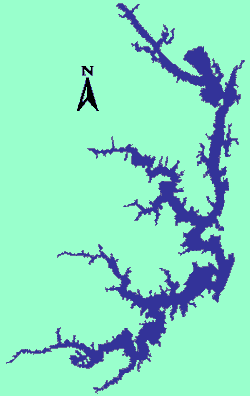Fishing
- Licenses & Regulations
- ShareLunkers
- Fish Identification
- Fish Consumption
- Texas Freshwater Fisheries Center
Water Resources
- Texas Reservoir Levels
- US Army Corps of Engineers
- Texas Water Issues
- Golden Alga
- Aquatic Vegetation
PO Box 116
Mathis, Texas 78368
(361) 547-6222, dial 5 Ext:241
Dusty McDonald, Biologist
Nearby State Park
Coleto Creek Reservoir
Quick Links: Fishing Regulations | Angling Opportunities | Cover & Structure | Tips & Tactics
Lake Characteristics
Location: Guadalupe River Basin, 15 miles
west-southwest of Victoria off US 59. Access road marked with
sign.
Surface area: 3,100 acres
Maximum depth: 46 feet
Impounded: 1980
Water Conditions
Current Lake Level
Conservation Pool Elevation: 98.28 ft. msl
Fluctuation: 1-3 feet
Normal Clarity: Clear to slightly stained
Reservoir Controlling Authority
Guadalupe-Blanco
River Authority
PO Box 68
Fannin, Texas 77960
(361) 575-6366
Aquatic Vegetation
Isolated beds of American lotus, cattail, and rushes
Predominant Fish Species
Lake Records
Current
Fishing Report
Stocking History
Latest Survey Report
Lake Maps
Maps of Coleto Creek Reservoir are available at the Coleto Creek Park headquarters and/or the bait shop near the lake. More detailed fishing maps are commercially available at most fishing tackle dealers in the south Texas area.
Fishing Regulations
All species are currently managed under statewide regulations.
Angling Opportunities
Largemouth bass is the most popular sportfish in the reservoir. Largemouth bass are abundant with frequent reports of five to eight pound fish being boated. White bass provide good angling opportunities in deeper water, near the dam. Blue, flathead and channel catfish also provide fisheries, and respectable catches of crappie are not uncommon.
| Species | Poor | Fair | Good | Excellent |
|---|---|---|---|---|
| Largemouth Bass | ||||
| White Bass | ||||
| Catfish | ||||
| Crappie | ||||
| Sunfish |
Fishing Cover/Structure
Coleto Creek Reservoir has varied types of habitat including steep rocky banks, flooded timber, shallow brushy flats, and creek channels. Water is generally clear throughout the year, while the creek channels are typically stained. Small coves and protected creek channels stay fairly clear throughout the year. In addition to the cover submerged timber and brush provide for game fish species, stands of native aquatic vegetation and hydrilla provide excellent habitat in most areas of the reservoir. Structure in the reservoir consist of islands, submerged humps and long sloping points extending cover with aquatic vegetation. Fish habitat structures were added to Coleto Creek in 2020.
Use the Habitat Structure Viewer for an interactive map of fish habitat structures and downloadable GPS coordinates.
Tips & Tactics
Largemouth bass anglers are most successful on during
the spring, fall, and winter months. Popular spring baits include spinnerbaits,
buzzbaits, rattletraps, crankbaits, and unweighted soft plastic
worms or jerkbaits.
Summer bass fishing can be frustrating for even the most experienced angler.
Topwater baits such as buzzbaits, Zara Spooks, or Pop-R's, presented very early
or very late in the day near weed beds, are popular and can be productive throughout
the day if cloud cover is present. Flipping jigs, plastic worms, or tube baits
in heavy shaded cover are often productive when nothing else seems to work.
Remenber to spool up with a heavier line when fishing thick cover. As summer
temperatures rise, some anglers concentrate on shaded areas in submerged vegetation
in 2-6 feet of water using soft plastics, while other anglers fish deep. Deep
water bass fishing is best using crankbaits, Texas-rigged worms, Carolina-rigged
plastics, or jigging spoons. Brushy main-lake points, rocky shorelines, submerged
roadbeds, and flooded brush near deep water or a dropoff are highly recommended
targets for bass when temperatures reach 90°F or higher.
White bass are
generally caught in the deeper water near the dam. Although live minnows
are a popular
bait, many anglers catch their limit using small rattletraps, shad
raps, small spinnerbaits, small grubs, and other minnow-imitating artificial
baits. As the weather cools, white bass may move to the
warm water discharge in the reservoir. Jigging spoons or small rattletraps
often put fish in the cooler during this time of year.
Catfish anglers can find channel, blue, and flathead catfish throughout the reservoir. Although many anglers prefer deeper water, catfish are often found in relatively shallow areas (8 feet or less) of flooded terrestrial vegetation. Stinkbait and cutbait produce impressive stringers of blue catfish, while the larger flathead and blue catfish seem to prefer live bluegill and shad. Trotlines and juglines account for many of the larger catfish caught every year at Coleto Creek.
Crappie fishing at Coleto Creek can be excellent. Crappie can be caught in the spring, in shallow water near submerged brush using minnows or small feather jigs. Summer crappie anglers concentrate their efforts in the main creek channels, near submerged timber using live minnows, feather jigs, and blade baits in 10-20 feet of water.
